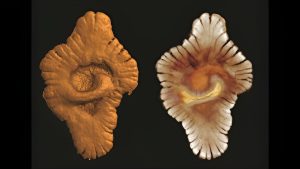
While life on Earth appeared extremely early in the planet’s history, it wasn’t until a mere 600 million years ago that complex life exploded onto the scene, with the long-standing reign of single-celled organisms giving way to more complex lifeforms, such as animals, fungi and plants. However, multicellular creatures may have evolved long before that, possibly beating the Earth’s Cambrian-era denizens to the punch by a full 1.5 billion years.
Dubbed the Cambrian explosion due to the seemingly explosive appearance of multicellular species in the fossil record, complex lifeforms began appearing in large numbers roughly 539 years ago, ending a four billion year stretch where the Earth’s dominant life forms were single-celled microorganisms, typically bacteria and bacteria-like achaea. It’s still unclear as to why evolution suddenly gave way to complex creatures at that point in time, although there is some speculation that large amounts of nutrient-laden sediments, scraped into the oceans by the massive glaciers that covered the Earth during a prior “Snowball Earth” period, may have provided the emerging organisms with extra fuel to power their more complex structures.
But researchers with Cardiff University are proposing that just such a scenario wasn’t exclusive to the relatively-recent Cambrian era: nutrient-rich environments could have been present in volcanically-active regions, such as the Franceville Basin, located near modern-day Gabon near Central Africa’s Atlantic coast.
“The availability of phosphorus in the environment is thought to be a key component in the evolution of life on Earth, especially in the transition from simple single cell organisms to complex organisms like animals and plants,” explained study lead Dr. Ernest Chi Fru, Reader at Cardiff University’s School of Earth and Environmental Sciences.
“We already know that increases in marine phosphorus and seawater oxygen concentrations are linked to an episode of biological evolution around 635 million years ago,” Chi Fru continued. “Our study adds another, much earlier episode into the record, 2.1 billion years ago.”
Chi Fru and his team propose that 2.1 billion years ago the merging of two ancient geological formations, the Congo and São Francisco cratons, simultaneously forced volcanic activity to the surface of the seafloor and isolated a portion of the water above from the larger ocean, forming an inland sea rich in volcanically-supplied nutrients, an ideal nursery for complex lifeforms to evolve in.
At the same time, photosynthesizing cyanobacteria were busy converting the atmosphere’s carbon dioxide into oxygen in quantities that could provide “sufficient energy to promote an increase in body size and greater complex behavior observed in primitive simple animal-like life forms such as those found in the fossils from this period,” Chi Fru said.
This notion adds evidence to an earlier discovery of fossils of slug-like creatures that appeared to have left trails on the seabed as they foraged for food, dated to the exact same period as the geological activity outlined in Chi Fru’s study.
“You’ve got little squiggles in the sediment,” remarked University of Alberta professor Kurt Konhauser, who was part of the team that uncovered the 2.1 billion-year-old fossils in 2019. “Whatever it was, it was moving up and down, pushing the sediment out of its way. They’re looking for something to eat.”
To put these time scales into perspective, there are indications that life has existed on Earth for nearly the entirety of its 4.55 billion year existence—that’s over one-third of existence of the known universe, to illustrate how ancient life on this planet is.
But for the vast majority of that time, life only existed as single-celled organisms, and it wasn’t until a mere 600 million years ago that multicellular lifeforms suddenly appeared on the landscape, during the brief, 25 million-year-long Cambrian explosion. However, if this new discovery is correct, that makes our evolutionary timeline nearly four times more ancient than previously thought.
Ultimately, these early organisms died out, a result of being unable to spread too far into the less-hospitable environment that lay beyond the landlocked comfort of their little sea, although their presence implies that the emergence of multicellular life was, at the very least, a two-phase process.
“While the first attempt failed to spread, the second went on to create the animal biodiversity we see on Earth today,” Chi Fru explained.
The notion of complex lifeforms evolving that early in our planet’s history could also have an impact on our understanding of how life might evolve on other planets. Mars, for instance, was home to an Earth-like climate for at least a billion years; although this is more than enough time to evolve single-celled lifeforms, it falls substantially short of the nearly 4 billion years that it took for complex organisms to gain a foothold on Earth—provided evolution was to follow similar paths on both planets.
But if these new discoveries are correct, it means that multicellular life doesn’t necessarily need nearly as much time as we thought it did to evolve, and other planets—possibly even ones in our own solar system—might very well hold more complex surprises than we expect.
Subscribers, to watch the subscriber version of the video, first log in then click on Dreamland Subscriber-Only Video Podcast link.